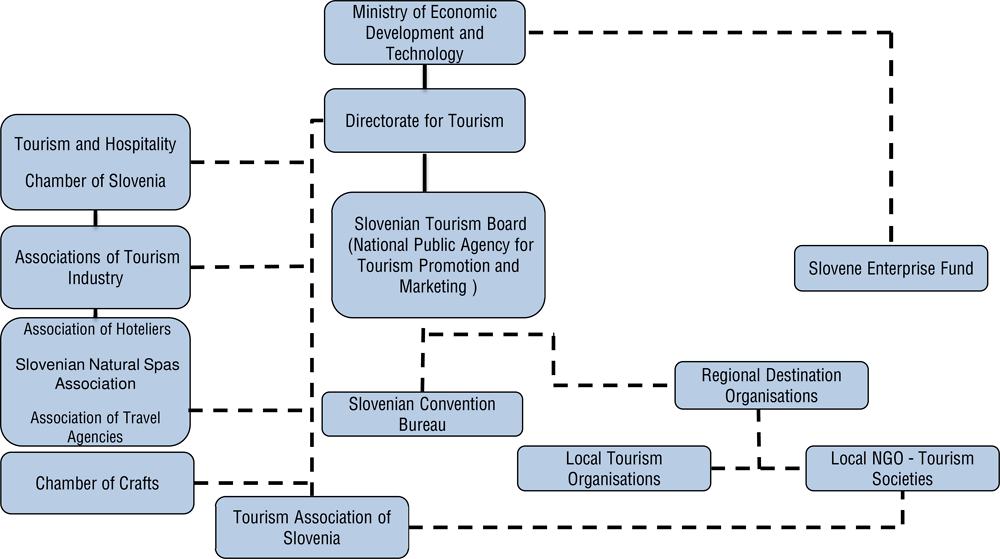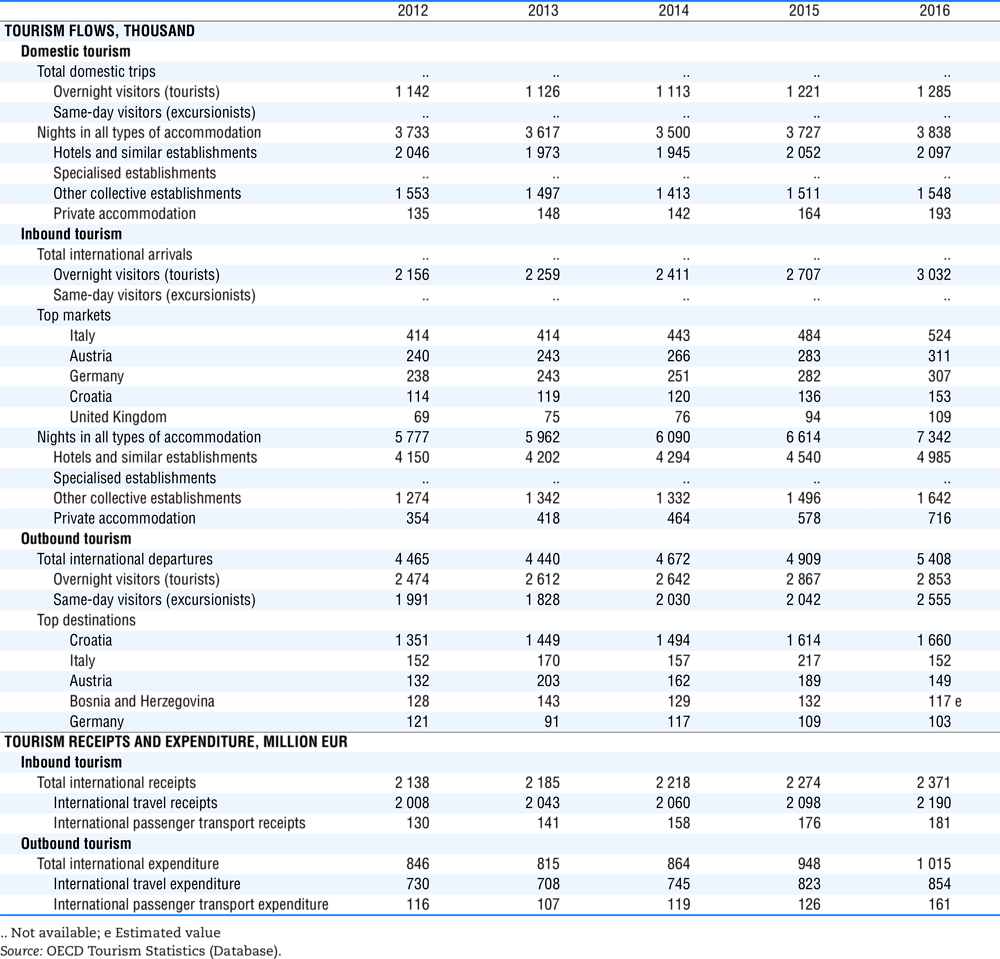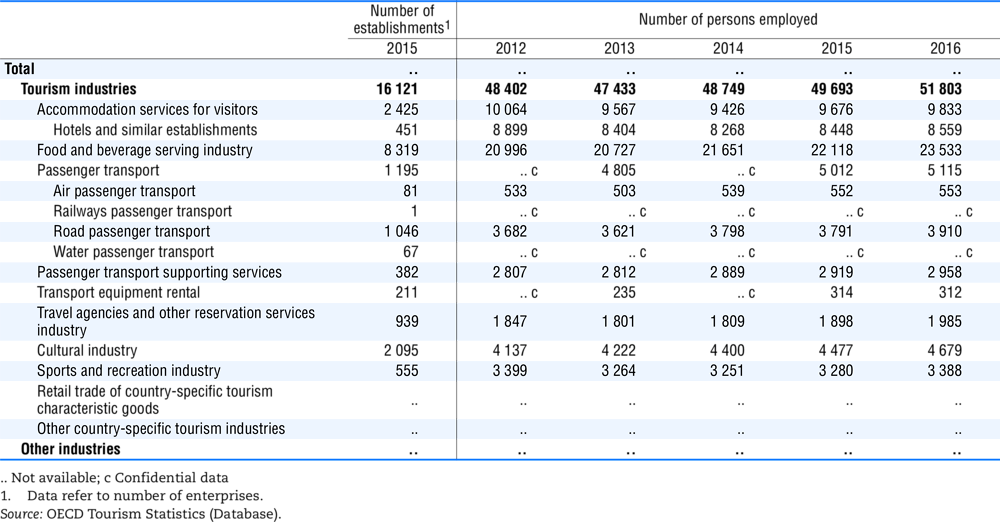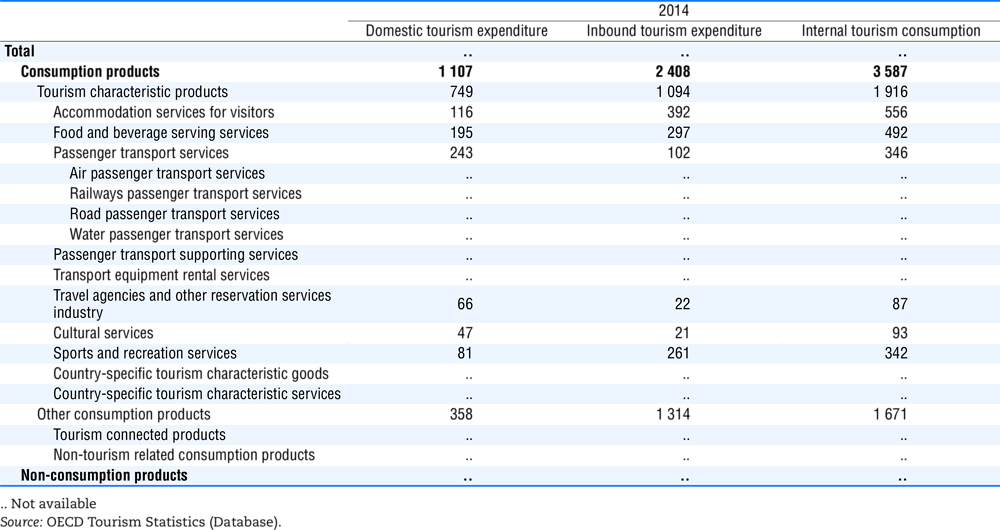Slovenia
Tourism in the economy
In 2016, Slovenia recorded more than 4.3 million overnight tourist arrivals, with over two-thirds of this number being inbound visitors (a 12% increase on 2015). Out of a total of 11.2 million nights in all means of accommodation, 7.3 million were generated by foreign tourists (up 11% on 2015) and 3.8 million by domestic tourists (up 3% on 2015). Tourism revenue is growing at a moderate pace, approximately 4% per year.
The largest visitor flows are from Slovenia’s neighbouring countries, including Italy (up 7.9% on 2015 for overnight stays), Austria (up 7.3% on 2015) and Germany (up 7.1% on 2015). Together they generate 37.7% of total overnight international arrivals. Slovenian’s undertook 5.4 million outbound trips in 2016, an increase of 10.1% from the previous year.
Tourism GDP increased by 4.4% between 2012 and 2014, to EUR 1.8 billion, representing 4.9% of total GDP. Total direct tourism employment increased from 48 700 jobs (6.1% of total employment) in 2014, to 51 800 in 2016 (up 6.3%). According to Bank of Slovenia data, export of travel services increased to EUR 2.3 billion in 2016 (up 3.9% from 2015), accounting for more than one third of all services exports, and 7% of total exports. The surplus of trade in travel services also increased in 2016 in year-on-year terms to EUR 1.5 billion.
Tourism governance and funding
The Ministry of Economic Development and Technology (MEDT) is the main governmental body responsible for producing and implementing national tourism policy as part of overall economic policy. Given the cross-cutting nature of tourism, it is regulated by a number of national laws requiring permanent cross-sectoral coordination. Legislation requires the adoption and implementation of a Tourism Strategy for a five-year period.
Strategic planning for Slovenian tourism policy reflects a partnership between the public and private sectors, and NGOs. The MEDT co-operates and consults primarily with the Chamber of Tourism and Hospitality, the Chamber of Craft and Small Business and the Tourism Association of Slovenia, engage in the strategic planning of tourism policy.
The promotion of Slovenia as a tourism destination and the corresponding marketing activities are the responsibility of the Slovenian Tourist Board (STB), a public agency which operates six offices in Europe and works with other promotional offices worldwide. The STB is also responsible for the infrastructure of tourist information, coordinating products, stakeholder networking and undertaking research and development.
Tourism development at regional level is undertaken by twelve Regional Development Agencies which are responsible to Regional Councils comprised of Mayors of local communities. Regional tourism development is governed by national legislation and the national development objectives of Slovenian tourism, which include some specific regional development objectives. The MEDT has sought to establish Regional Destination Organisations (RDOs) with the aim of achieving better integration of local tourism destinations. RDOs now operate specific development and marketing programmes and destination brands in each of the twelve statistical regions.
At the local level, each mayor and community council is responsible for tourism development according to national legislation and national strategic objectives. A locally collected tourist accommodation tax goes directly to the community budget. It is the main financial source for local tourism development and is dedicated for this purpose, including construction of information centres, trails, parks, and sports facilities, along with local marketing activities. In 2016, the tourist tax receipts amounted to EUR 11.8 million.
The national budget for promotion and development of tourism in 2017 is EUR 16.1 million, including EUR 11.4 million for marketing and development of tourism and EUR 2.2 million for the Slovenian Tourism Board. In addition, European funds to the value of EUR 2.5 million have been allocated for the creation of new tourism projects and the development of tourism infrastructure.

Source: OECD, adapted by the Ministry of Economic Development and Technology, 2018.
Tourism policies and programmes
The Government of the Republic of Slovenia adopted in October 2017 the new Development Strategy for Sustainable Growth of Slovenian Tourism 2017-2021. The primary objective of which is to increase the competitiveness and visibility of Slovenian tourism. The key task of the Government is to provide a conducive environment for business and investment in all sectors, including tourism. This implies an appropriate regulatory framework and development incentives for investment. The strategy will focus on five key policy areas:
-
Organisation. Reorganising the structure of tourism in Slovenia, into four macro regions with the greatest potential for development: Alpine Slovenia, Mediterranean Slovenia, Thermal Pannonian Slovenia, and Central Slovenia with the capital Ljubljana.
-
Institutional and legal issues. Reducing administrative barriers to improve the development of tourism SMEs, including rules on the categorisation of accommodation establishments and on minimum technical conditions for catering and tourism business activities. Revising current legislation including a new Promotion of Tourism Development Act, new Lipica Stud Farm Act and an amended Hospitality Industry Act.
-
Investment. Launching a new cycle of investment in both greenfield and brownfield sites for the development of tourism infrastructure, including private and public investments.
-
Small and medium-sized enterprises (SMEs). Promoting the development of new tourism SMEs, and the development of competitiveness and productivity of existing tourism SMEs.
-
Human resource development. Promoting the training and education of tourism personnel in line with the needs of tourism enterprises, and promoting vocational education and skills for tourism.
One of the key activities of the Slovenian Tourist Board in 2016 was the promotion of Slovenia as a green, active and healthy boutique destination. At the core of the promotional activities was the digital campaign, “Slovenia – Make New Memories”, which the Slovenian Tourist Board implemented in co-operation with the Slovenian tourism industry in thirteen international markets.
A number of key policies and actions have been identified for the next five year programme. These include:
-
Promotion of investments in sustainable and innovative tourist offers/services, in line with brand positioning embodied in the above promotion,
-
Introduction of new information technologies in the field of promotion and marketing of national tourism,
-
Transport policy measures that will affect tourism, including support for the development and establishment of new air, rail, maritime and other transport routes and services to improve accessibility and investment in the renovation and construction of cableways and cycle networks,
-
Associated actions related to cultural policy, including investment in the renovation of built cultural heritage of particular significance to tourism, such as castles, manors, monasteries, etc.,
-
New investments in tourist information centres and in infrastructure for congress tourism.
In positioning Slovenia as a boutique destination in the heart of Europe, one of the main challenges will be attracting new investment in tourism infrastructure within the four principal regions. The most visited facilities are health resorts, seaside resorts and mountain resorts, and all require investment in tourism infrastructure that meets Slovenia’s positioning as “Green, active and healthy”. Slovenia needs new investment in building new accommodation capacity, renovating the existing accommodation portfolio, and in new tourist attractions and general infrastructure. Within this framework and brand positioning, the Government will particularly promote investment that is environmentally sustainable, of high quality, and capable of attracting interest outside the main tourist seasons. The aim will be to “de-season” Slovenian tourism while improving the competitiveness, productivity and sustainability of tourism SMEs.



